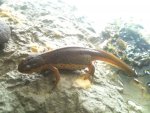Naut
New member
- Joined
- Oct 25, 2011
- Messages
- 15
- Reaction score
- 0
- Points
- 0
- Country
- Viet Nam
I found my newt in the wild and he's a yellowish/olive color. I noticed pictures and videos of other Eastern Red Spotted Newts being a blue-ish color with more of an aquatic tail. Does this mean my newt hasn't reached a full mature adult stage? He's aquatic about 90% of the time despite his pointy tail.
and Here's the blue-ish newts I've seen with a more developed tail.
Red-spotted Newt Courtship - YouTube
I was just wondering what makes up this difference in looks.
and Here's the blue-ish newts I've seen with a more developed tail.
Red-spotted Newt Courtship - YouTube
I was just wondering what makes up this difference in looks.

